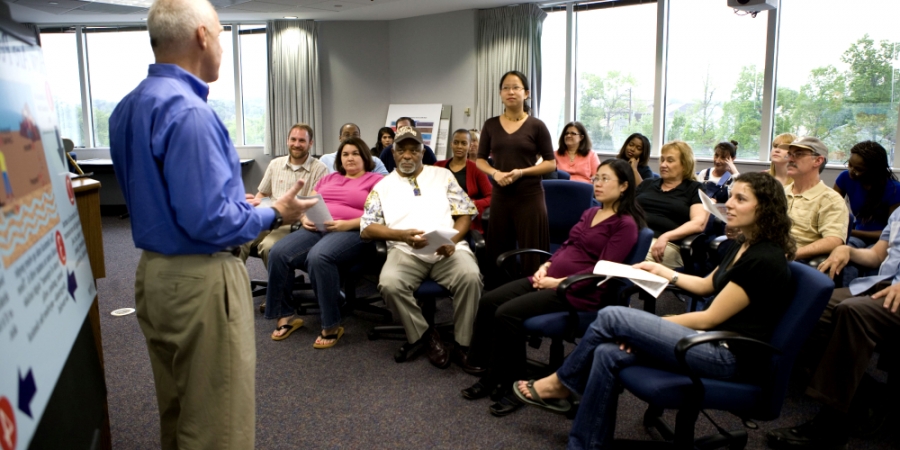"Schools which encourage collaboration can thrive."
Why is it important to look outwards, both as schools and leaders within our schools? How can leaders at all levels - middle leaders, senior leaders and heads - benefit from collaboration both within their school communities and across different schools? What can any teacher - as all are leaders of learning in their own classrooms – both give and gain from collaborating with others?
Collaboration is difficult, perhaps financially straitened times, when we feel under pressure from high stakes accountability measures, and when we are coping with rapidly paced change, can seem almost counter-intuitive. Should we not simply batten down the hatches and focus on our own schools, and, within those schools, on our own classrooms? Do partnerships, dialogue and sharing take valuable time and energy when our priority, perhaps as a school that Requires Improvement or is in Special Measures, should be our own practice? As Steve Munby, when he was Chief Executive of the National College, was fond of saying, “When the watering hole begins to shrink, the animals start to look at each other differently.”
And yet schools which encourage collaboration and a broader perspective, which focus on making the most of the complementary skills of all staff across the organisation, and which are committed to both supporting and learning from those in other schools, can thrive. Collaboration can strengthen us, and, arguably, if we are currently constrained by an RI or SM judgement, that is when we most need to develop and grow stronger. It is also when we need to recognise acutely that, whatever the overarching inspection judgement, there will be plenty of examples of good practice in the organisation - strong departments, highly capable individuals, who have expertise they can share with others within and beyond the school, which can reinforce their sense of self efficacy and help others to grow.
As Dylan Wiliam has said, we need to focus on working AS a team, not just IN a team. Being clear about the potential positive contribution of individuals and groups across the school, and recognising areas for development and what we can also gain from what others have to offer, is key. In this way the whole of the team, and of the school, can be greater than the sum of its parts. And knowing that we have supported others, and expressing gratitude for help we have received, can serve to boost our confidence and help to address negative stress, as Alex Quigley explores in The Confident Teacher (2016).
Building on the positives can also take us further than fixating on the negatives. The principle of Appreciative Enquiry, a credit rather than a deficit mode of institutional improvement, encourages us to seek out the ‘bright spots’, focussing on and learning from what is going well rather than simply being preoccupied with what is broken and how we can fix it. This idea of finding the bright spots is at the heart of Chip and Dan Heath’s excellent book Switch: How to Change Things When Change is Hard (2011) and it is also a key idea explored by Shaun Allison and Andy Tharby in Making Every Lesson Count. When we plan collaboration and work in partnership within our schools and across our schools, an Appreciative Enquiry approach can take us far.
"There needs to be parity of contribution, as everyone has something to offer and something to gain."Collaboration across schools, sharing with and learning from others, has gained momentum in recent years with the development of social networking for educational professional development: Twitter, blogging and spin-off events such as TeachMeets and conferences. Often virtual contacts lead to face-to-face meetings and develop into even more dynamic, supportive relationships which have mutual benefit. As Bridges claims (2001), “People who share certain kinds of experience in common stand in a special position in terms of understanding those shared aspects of experience”, so meeting others at a similar stage of their professional journey (for example through programmes such as NPQML, NPQSL and NPQH, or induction events for new school leaders) can prove reassuring and a source of practical guidance and learning. Barber et al (2010) refer to the power of this “lateral learning”, as you collaborate with your peers. There needs to be parity of contribution, as everyone has something to offer and something to gain. As David Carter, the National Schools Commissioner, explored in his address at The Telegraph Festival of Education on the 23rd June 2016, true partnerships involve both partners giving and benefiting.
Those who use Twitter regularly may well be familiar with online chats: subject chats, and those for middle leaders (#MLTchat) and senior leaders (#SLTchat) which offer the opportunity to engage online with those in similar roles facing similar challenges and sharing opportunities, advice and salutary experiences. I remember one #SLTchat in October 2012 where one of the topics was Managing Challenging Conversations. After the dynamic exchange of experiences, advice, debate and reflection, it struck me that this could be the best possible preparation for any leader going into school the next morning to “eat the frog” of a difficult conversation. Benefiting from the virtual discussion of how such conversations could best be prepared for and conducted might enable us to ensure a win-win outcome whereby both participants feel more positive by the end of the meeting, and a constructive way forward identified.
Twitter as a collaborative mechanism may have its detractors, but I think of the advice that, “If you are the most intelligent person in the room, you need a bigger room.” It seems to me that Twitter is The Room.
So think of how you gained from collaboration within your school, and across schools, in the last academic year, and also consider what you have brought to the table, and how others may have benefited from your contribution.
How might you make even more positive, constructive and mutually enriching use of collaboration this year?
Thank you for reading.
References:
Allison, S. and Tharby, A. (2015) Making Every Lesson Count Camarthen : Crown House
Barber, M., Whelan, F., Clark, M. (2010) Capturing the Leadership Premium: How the World’s Top School Systems are Building Leadership Capacity McKinsey and Company Report
Bridges, D. (2001) The Ethics of Outsider Research
Buck, A. (2014) What Makes a Great School? 3rd edition (Kindle Edition) Leadership Matters:
https://www.amazon.co.uk/What-Makes-Great-School-Practical-ebook/dp/B00NBW4J4C
Quigley, A. (2016) The Confident Teacher Abingdon : Routledge
How will you embrace collaboration going forward? Let us know below!


















